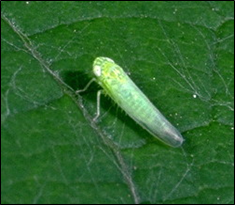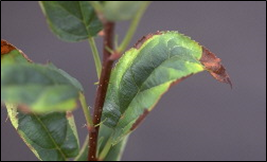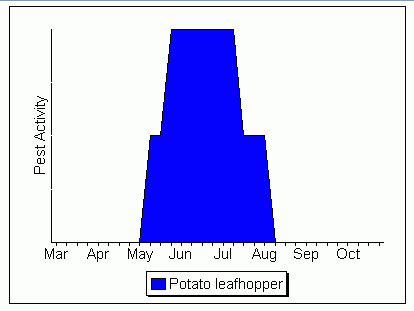Potato Leafhopper in Alfalfa
Potato Leafhopper
Potato leafhoppers are the major pest of second, third, and fourth cuttings in established fields. They can cause

Potato Leafhopper
serious damage before the first cutting in fall- and spring-seeded fields. Their feeding produces a distinctive, yellow triangular area at the tip of the leaf that is called "hopper burn".
Description
Adults of the potato leafhopper are green, wedge-shaped insects less than 1/8 inch long. Eggs are laid in the stems and larger veins of the host plant. Nymphs resemble adults in general shape but are much smaller and do not have wings. These insects use their piercing-sucking mouthparts to feed on plant sap. In warm weather, the leafhopper life cycle takes about three weeks. There can be 3 to 4 generations each year with damage usually ending in mid-July.
Damage

Hopperburn caused by leafhoppers
Potato leafhopper feeding damages vascular tissue and blocks sap flow in leaves, producing the triangular-shaped yellowing at the tip of the leaves called "hopper burn". This greatly reduces hay quality. Regrowth following cutting can be delayed, plants can be stunted, and plant root reserves can be reduced. Once hopper burn is obvious in the field, the damage to the crop has been done.
Potato Leafhopper Activity

Please note: Actual dates vary from season to season, these are approximations only. This calendar was constructed using data from Kentucky, USA. Contact your county extension agent or agricultural consultant for information tailored to your locality.
IPM Techniques and Scouting Procedures
The amount of damage that potato leafhoppers cause is related to the size of insect population and height of alfalfa. Damaging numbers must be determined before symptoms appear.
- Established fields should be sampled after first cutting, while new fields (fall- or spring-seeded) should be sampled beginning about May 25.
- Sample each field once a week, starting about 10 days after the first cutting. Use a 15" diameter sweep net to take samples at 5 randomly-selected locations in the field.
- Take 20 sweeps at each location and count all potato leafhopper adults and nymphs collected at each location.
- Ten stems from the field should be measured to determine average plant height. Also record the number in pre-bud, bud or flower stage to determine if early harvest is a potential control option.
- Cutting at about 35 day intervals usually keeps leafhoppers from reaching damaging levels.
- Control decisions are made using the Treatment Guideline Table for Potato Leafhoppers.
References and Additional Information
- IPM-1 Kentucky Alfalfa IPM Manual. 1992.
EntFact-115 Potato Leafhoppers


